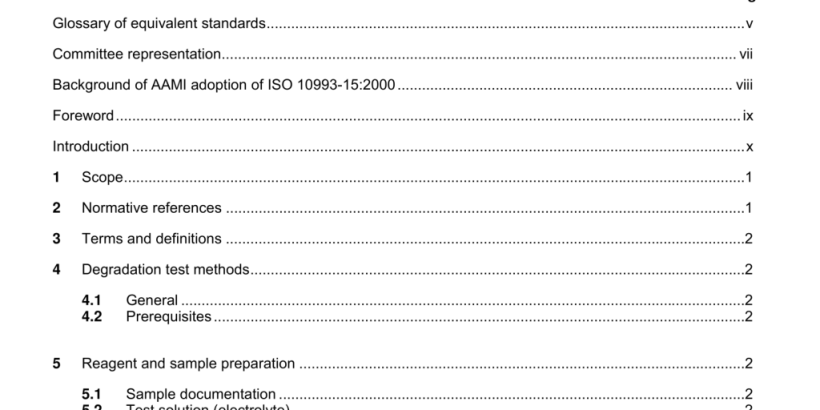ANSI AAMI ISO 10993-15-2000 pdf download
ANSI AAMI ISO 10993-15-2000 pdf download.Biological evaluation of medical devices
1 Scope
This part of ISO 10993 provides guidance on general requirements for the design of tests for identifying and quantifying degradation products from finished metallic medical devices or corresponding material samples finished as ready for clinical use. It is applicable only to those degradation products generated by chemical alteration of the finished metallic device in an in vitro accelerated degradation test. Because of the accelerated nature of these tests, the test results may not reflect the implant or material behavior in the body. The described chemical methodologies are a means to generate degradation products for further assessments. This part of ISO 10993 is not applicable to degradation products induced by applied mechanical stress. NOTE- -Mechanically induced degradation, such as wear, may be covered in the appropriate product-specific standard. Where product-group standards provide applicable product-specific methodologies for the identification and quantification of degradation products, those standards should be considered. Because of the wide range of metallic materials used in medical devices, no specific analytical techniques are identified for quantifying the degradation products. The identification of trace elements (< 10 ) contained in the specific metal or alloy is not addressed in this part of ISO 10993, nor are specific requirements for acceptable levels of degradation products provided in this part of ISO 10993. This part of ISo 10993 does not address the biological activity of the degradation products; see instead the applicable clauses of ISO 10993-1 and ISO 10993-17.
2 Normative references
The following normative documents contain provisions which, through reference in this text, constitute provisions of this International Standard. For dated references, subsequent amendments to, or revisions of, any of these publications do not apply. However, parties to agreements based on this International Standard are encouraged to investigate the possibility of applying the most recent editions of the normative documents indicated below. For undated references, the latest edition of the normative document referred to applies. Members of ISO and IEC maintain registers of currently valid International Standards.
4.1 General
To identify and quantify degradation products from metals and alloys in medical devices, a combination of two procedures is described. The choice of test procedure shall be justified according to the function of the medical device. The first procedure described is a combination of a potentiodynamic test and a potentiostatic test. The second procedure described is an immersion test. The potentiodynamic test is used to determine the general electrochemical behavior of the material under consideration and to determine certain specific points (Ea and Ep) on the potential/current density curve. The immersion test is used to chemically degrade the test material to generate degradation products to be analyzed. If there is the possibility of the loss of a coating from a metallic substrate due to degradation, the potential degradation products from the substrate material shall be considered, as well as the coating itself. In addition, if a metallic substrate coated with a non-metallic material is to be tested, the requirements of ISO 10993-13 and/or ISO 10993-14 shall be considered in order to determine the potential degradation products of the coating. The identified and quantified degradation products form the basis for evaluation of biological response and, if appropriate, toxicokinetic studies in accordance with Iso 10993-16.
4.2 Prerequisites
The rates of electrochemical degradation reactions are sensitive to small variations in test conditions, instrumentation, sample conditions, and preparation. Therefore, electrochemical degradation testing shall be carried out in an appropriately equipped laboratory by experienced and qualified personnel. This includes proper maintenance and calibration of the test equipment. The methods and operating conditions of the equipment shall also be validated. NOTE- Fufllment of electrochemical test conditions for stability, warm-up time, etc., can be demonstrated by conformance to [1].
